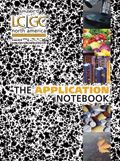Single Calibrant Approach for the Analysis of Unknowns Using Dual Gradient Pump and Charged Aerosol Detection
Quantification of substances, such as drug impurities or library compounds when pure standards are not available is difficult yet often necessary.
Quantification of substances, such as drug impurities or library compounds when pure standards are not available is difficult yet often necessary. This is often accomplished by HPLC based on relative response using low wavelength UV detection. The dependence of response on the optical properties of each component can lead to large errors in estimated quantity. The Corona® Charged Aerosol Detector (CAD)® is a mass sensitive detector which has been shown to provide near uniform response for nonvolatile analytes provided that the eluent remains constant (1). Response, however, can change during gradient conditions. An effective way to normalize response is to use an inverse gradient post-column addition (2). The Dionex UltiMate® 3000 RSLC system equipped with dual gradient pump (DGP) greatly facilitates the use of two simultaneous gradient profiles on one HPLC/UHPLC platform. This application note illustrates the use of CAD with this DGP system for single calibrant estimation of unknown substances.

Figure 1
Materials and Methods
A Dionex UltiMate 3000 RSLC system equipped with a DGP- 3600RS pump, with a Corona ultra™ CAD (Figure 1).
HPLC Parameters:
Column: Acclaim® RSLC 120 C18 3 µm 120 Å, 3.0 × 33 mm
Column Temperature: 30 °C
Mobile Phase A: 10 mM Ammonium Acetate, pH = 4.5
Mobile Phase B: Acetonitrile
Flow Rate: 1.0 mL/min each pump (2 mL/min to detector)
Injection Volume: 2 µL
Corona ultra: Nebulizer Temperature: 25 °C; Filter: High
A group of nine chemically diverse compounds were dissolved and then combined to give a mixture of equal mass concentration for each analyte.
Results
Five replicate injections were made at each of 5 concentration levels from 11 to 170 ng on column. The correlation coefficients for all nine linear fit curves were ≥ 0.999. Back calculations using the nine curves at each calibrant's 20 ng on column level yielded 81 data points of which 89% fell within 50% of their expected values. If the data related to one outlier (SDS) is removed, then 98% of the results fall within 50% of their expected values. UV data for the same sample set does not allow for these calculations across the entire set. Only five peaks are detected at 254 nm and six peaks at 210 nm with an overall response deviation between analytes which is five to six times higher then that observed on the CAD.
Conclusion
Quantification of substances in the absence of pure standards is necessary in many stages of the pharmaceutical process. A single UltiMate 3000 DGP-RSLC platform with Corona ultra detection provides a simple means of obtaining better uniformity of response than low wavelength UV for nonvolatile analytes. This improves the estimation of unknowns without the need for analytical standards for all components. The sensitivity and quantitative accuracy provided by this approach may be useful for many applications such as analysis of impurities and degradants, monitoring compound synthesis, and quality of library compounds, cleaning validation and mass balance experiments.
References
(1) Dependence of Response on Chemical Structure, ESA - A Dionex Company Application Brief 70-8913.
(2) T. Gorecki, F. Lynen, R. Szucs, P. Sandra, Universal response in liquid chromatography using charged aerosol detection, Anal. Chem., 78 (9), 3186–3192 (2006).
Corona, UltiMate, and Acclaim are registered trademarks, and ultra is a trademark of Dionex Corporation.

ESA – A Dionex Company, Inc.
22 Alpha Road, Chelmsford, MA 01824
tel. (978)250-7000; fax (978)250-7090
Websites: www.coronaultra.com; www.dionex.com.

Infographic: Be confidently audit ready, at any time and reduce failures in pharma QC testing
November 20th 2024Discover how you can simplify the audit preparation process with data integrity dashboards that provide transparency to key actions, and seamlessly track long-term trends and patterns, helping to prevent system suitability failures before they occur with waters_connect Data Intelligence software.